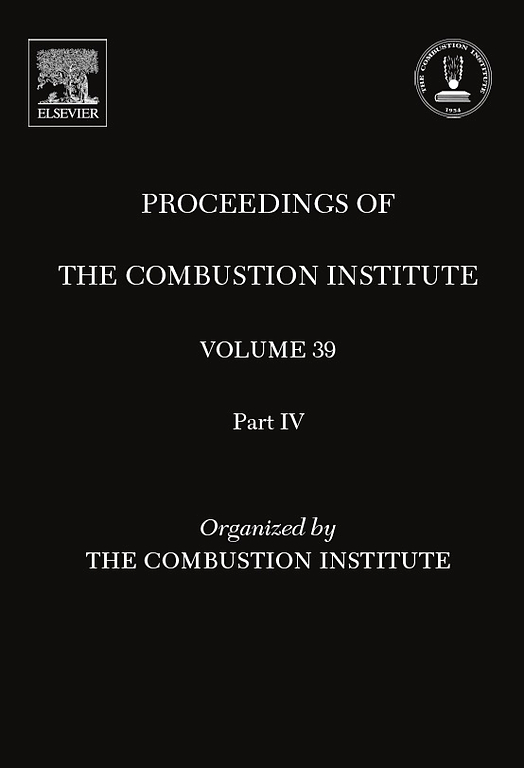Investigation of the near-field structure and stability of non-premixed NH[formula omitted]/H[formula omitted]/N[formula omitted] jet flames at various pressure and co-flow conditions
IF 5.3
2区 工程技术
Q2 ENERGY & FUELS
引用次数: 0
Abstract
Inspired by the attractiveness of ammonia as an energy carrier coupled with the relative lack of experimental data at industrially-relevant conditions for ammonia/ammonia-blended flames, the current work was undertaken to help fill gaps in our understanding. This study reports the structure and stability of non-premixed, simulated cracked ammonia jet flames at three different cracking ratios (CR) (40%, 50%, and 60%) and pressures (1, 2, and 3 bar), and two different co-flow temperatures (295 and 573 K) using a newly commissioned high-pressure and temperature combustion duct. Measurements of qualitative OH and NO via PLIF were conducted to study the near-field flame structure. The results revealed that the detachment velocity increases monotonically with CR, however for a given CR, the detachment velocity decreases with pressure. For CR 55%, the jet flame exhibits a stable lifted flame behavior whereas blowout occurs directly after detachment for CR 55%. The visible flame length/size tends to slightly increase with pressure for the unheated co-flow cases, while the opposite trend was observed for the heated co-flow cases. As CR increases, the flame length/size slightly decreases regardless the pressure and co-flow temperature. It was observed that increasing CR increases the intensity of OH radicals while the NO intensity is reduced. It is suggested that the mismatch between peak NO and OH locations, which increases with CR, promotes the thermal-NO pathway rather than the fuel-NO pathway. Overall, increasing the pressure and co-flow temperature leads to a significant decrease in the peak NO and OH mismatch. Furthermore, as the pressure increases, both OH and NO intensities decrease when the co-flow is at room temperature. Nevertheless, increasing the pressure in the heated co-flow flames results in decreasing OH intensity while increasing that of the NO. This discrepancy between co-flow temperatures with pressure indicates the need for further investigation.不同压力和同流条件下非预混合 NH[式略]/H[式略]/N[式略]喷射火焰的近场结构和稳定性研究
氨作为一种能量载体极具吸引力,但在氨/氨混合火焰的工业相关条件下却相对缺乏实验数据,受此启发,我们开展了当前的研究工作,以帮助填补我们的认识空白。本研究报告了在三种不同的裂解率(CR)(40%、50% 和 60%)和压力(1、2 和 3 巴)以及两种不同的共流温度(295 和 573 K)条件下,使用新调试的高压和高温燃烧管道模拟的非预混合裂解氨喷射火焰的结构和稳定性。通过 PLIF 对定性 OH 和 NO 进行了测量,以研究近场火焰结构。结果表明,脱离速度随 CR 的增加而单调增加,但对于给定的 CR,脱离速度随压力的增加而降低。对于 CR 55%,喷射火焰表现出稳定的抬升火焰行为,而对于 CR 55%,脱离后会直接喷出。在未加热的同流情况下,可见火焰的长度/大小随着压力的增加而略有增加,而在加热的同流情况下则出现相反的趋势。随着 CR 的增加,无论压力和同流温度如何,火焰长度/大小都会略微减小。据观察,CR 的增加会增加 OH 自由基的强度,而 NO 的强度则会降低。这表明,随着 CR 的增加,NO 和 OH 的峰值位置不匹配,促进了热-NO 途径,而不是燃料-NO 途径。总体而言,提高压力和共流温度会显著降低 NO 和 OH 的峰值错配。此外,随着压力的增加,当共流物处于室温时,OH 和 NO 的强度都会降低。然而,在加热的同流火焰中增加压力会导致 OH 强度下降,而 NO 强度上升。共流体温度与压力之间的这种差异表明需要进一步研究。
本文章由计算机程序翻译,如有差异,请以英文原文为准。
求助全文
约1分钟内获得全文
求助全文
来源期刊

Proceedings of the Combustion Institute
工程技术-工程:化工
CiteScore
7.00
自引率
0.00%
发文量
420
审稿时长
3.0 months
期刊介绍:
The Proceedings of the Combustion Institute contains forefront contributions in fundamentals and applications of combustion science. For more than 50 years, the Combustion Institute has served as the peak international society for dissemination of scientific and technical research in the combustion field. In addition to author submissions, the Proceedings of the Combustion Institute includes the Institute''s prestigious invited strategic and topical reviews that represent indispensable resources for emergent research in the field. All papers are subjected to rigorous peer review.
Research papers and invited topical reviews; Reaction Kinetics; Soot, PAH, and other large molecules; Diagnostics; Laminar Flames; Turbulent Flames; Heterogeneous Combustion; Spray and Droplet Combustion; Detonations, Explosions & Supersonic Combustion; Fire Research; Stationary Combustion Systems; IC Engine and Gas Turbine Combustion; New Technology Concepts
The electronic version of Proceedings of the Combustion Institute contains supplemental material such as reaction mechanisms, illustrating movies, and other data.
 求助内容:
求助内容: 应助结果提醒方式:
应助结果提醒方式:


